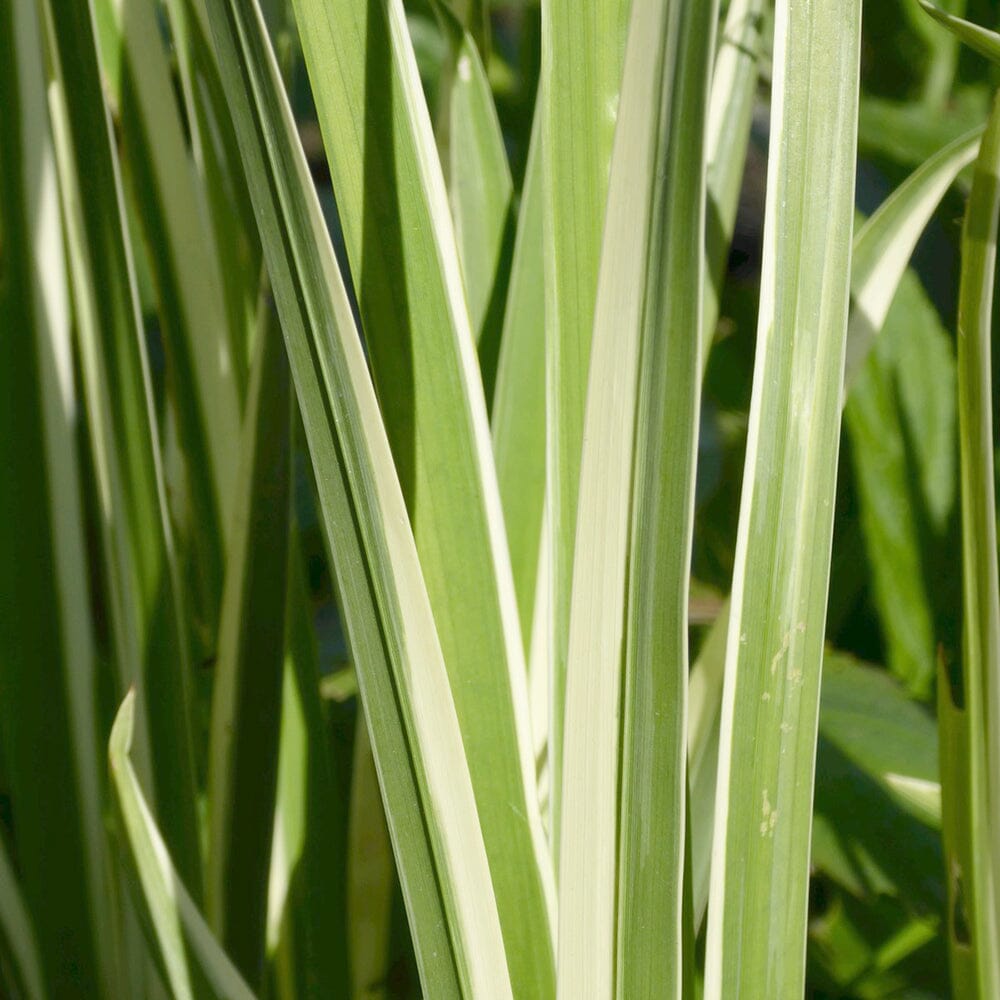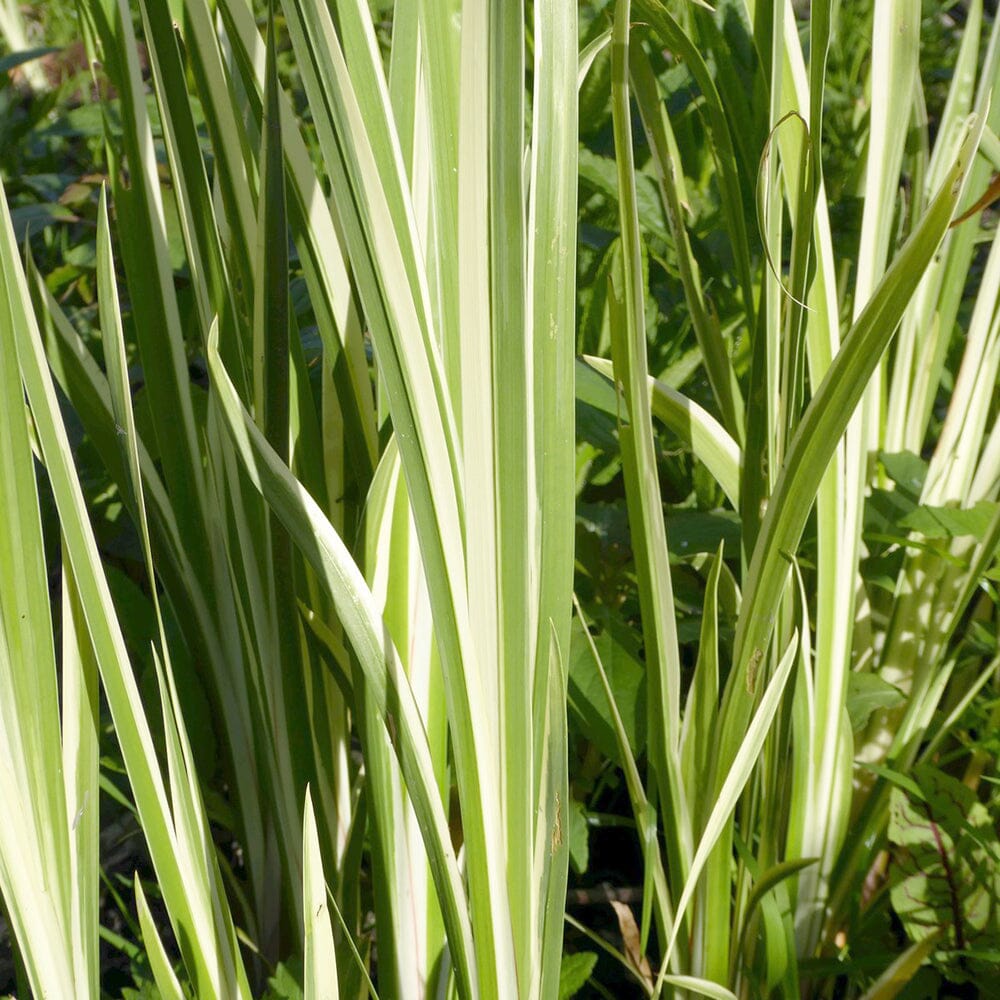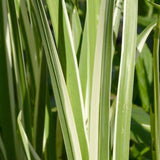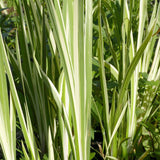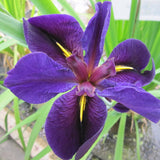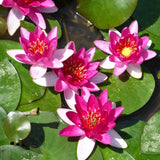Acorus Calamus Variegatus Aquatic Pond Plant - Sweet Flag
Acorus calamus variegatus, also known as Variegated Sweet Flag or Variegated Calamus, is a cultivar of Acorus calamus. It is valued for its striking variegated foliage, featuring creamy-white and green stripes.
Here's a detailed description and care guide for Acorus calamus variegatus:
Description:
Acorus calamus variegatus is a perennial, semi-aquatic plant that grows in clumps. It exhibits long, slender leaves with creamy-white and green variegation. The leaves are strap-like and have a graceful arching habit. The variegation adds visual interest and makes it a popular choice for ornamental gardens, water features, and container plantings. It produces inconspicuous flowers on tall stalks, but the primary attraction of this cultivar is its striking foliage.
Care Guide:
Lighting: Acorus calamus variegatus thrives in full sun to partial shade. It prefers bright light but can tolerate some shade. In hot regions, providing partial shade during the hottest part of the day can prevent leaf scorching.
Water: Acorus calamus variegatus prefers moist to wet soil conditions and can tolerate shallow water up to a few inches deep. It grows well in marshy areas, bogs, or along the edges of ponds or water gardens. Ensure that the soil or planting medium remains consistently moist, but not waterlogged. Avoid allowing the plant to dry out completely.
Soil: Acorus calamus variegatus prefers fertile, loamy soil that is rich in organic matter. It thrives in slightly acidic to neutral soil with a pH range of 6.0 to 7.5. If planting in containers, use a well-draining aquatic planting medium that retains moisture.
Temperature: Acorus calamus variegatus is hardy in USDA hardiness zones 4-10. It can tolerate a wide range of temperatures but prefers mild to cool climates. In hot regions, provide some shade to prevent heat stress.
Fertilization: Acorus calamus variegatus generally does not require heavy fertilization. However, you can provide a balanced, slow-release fertilizer once a year in early spring to support healthy growth. Follow the package instructions for the appropriate dosage.
Maintenance: Acorus calamus variegatus is a low-maintenance plant. Regularly remove any dead or damaged foliage to maintain its appearance. If the plant becomes overcrowded, divide the clumps every few years to rejuvenate growth. Trim back any flowers or seed heads to promote vegetative growth.
Pests and Diseases: Acorus calamus variegatus is generally resistant to pests and diseases. However, keep an eye out for common garden pests such as aphids or snails, and take appropriate measures if necessary. Avoid overwatering, as it can lead to root rot.
Propagation: Acorus calamus variegatus can be propagated through division. Divide the clumps in early spring or fall, ensuring that each division has a healthy portion of rhizome and foliage. Replant the divisions in suitable soil or planting medium and keep them adequately watered until established.
Caution: It's important to note that Acorus calamus variegatus contains certain compounds that may be toxic if ingested in large quantities. Keep it out of reach of children and pets. Consult local regulations regarding its cultivation and use in your area.
By following these care guidelines, you can enjoy the striking variegated foliage of Acorus calamus variegatus in your garden or water feature. Adjust the care routine based on your specific growing conditions and monitor the plant for any signs of stress or disease. With proper care, Acorus calamus variegatus can provide a visually appealing and unique addition to your landscape.
Selection:
Research different species of marginal pond plants to find ones that suit your pond's conditions and your aesthetic preferences. Consider factors such as height, flower colour, foliage texture, and seasonal interest when selecting plants.
Placement:
Observe the natural conditions of your pond, such as sun exposure, soil type, and water movement, and choose plants that are adapted to those conditions. Create different planting zones around the pond, with plants that prefer wet soil closer to the water's edge and those that tolerate drier soil further away.
Sunlight:
Marginal plants typically thrive in full sun to partial shade. Some species can tolerate more shade, but for optimal growth and flowering, provide them with at least 6 hours of direct sunlight per day.
Water Depth:
Determine the water depth requirements of the marginal plants you choose. Some plants prefer water up to 6 inches deep, while others can tolerate water up to 12 inches or more. Ensure that the water level remains consistent within the preferred range for the chosen plants.
Soil:
Marginal plants prefer a rich, loamy soil that retains moisture but is not waterlogged. Amend the soil with organic matter, such as compost or well-rotted manure, to improve its fertility and drainage. Avoid using heavy clay soil, as it can become compacted and restrict root growth.
Planting:
Dig a hole slightly larger than the root ball of the plant and loosen the soil at the bottom. Place the plant in the hole, ensuring that the crown is level with or slightly above the soil surface. Backfill the hole with soil and gently firm it around the plant to eliminate air pockets. Water thoroughly after planting to settle the soil and provide initial hydration.
Mulching:
Apply a layer of organic mulch around the base of the plants to suppress weeds, conserve moisture, and regulate soil temperature.Use materials like straw, shredded bark, or compost, and maintain a depth of 2-3 inches.
Watering:
Marginal plants prefer consistently moist soil but should not be waterlogged. Monitor the moisture level regularly and water as needed to keep the soil evenly moist. During hot and dry periods, provide supplemental watering to prevent the soil from drying out.
Fertilization:
Marginal plants generally do not require heavy fertilization if the soil is nutrient-rich. However, if growth appears weak or leaves show signs of nutrient deficiencies, apply a balanced slow-release fertilizer according to the manufacturer's instructions.
Maintenance:
Remove any yellowing or dead leaves to maintain plant health and appearance. Divide overcrowded plants every few years to prevent competition for resources and promote vigorous growth. Prune back excessive growth to maintain a tidy appearance and to prevent plants from encroaching on other plants or the pond itself.
Winter Care:
Hardy marginal plants can withstand winter temperatures and require minimal care. Cut back dead foliage in late fall or early spring to tidy up the planting area. In colder regions, consider protecting tender plants with a layer of mulch or covering them with burlap during winter to prevent frost damage.
Monitoring and Troubleshooting:
Regularly inspect plants for signs of pests, diseases, or nutrient deficiencies. Address any issues promptly with appropriate treatments, such as organic insecticides, fungicides, or nutrient amendments. By following these detailed tips and providing proper care, you can create a beautiful and thriving planting zone around your pond, enhancing its visual appeal and supporting a diverse ecosystem.








